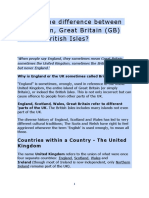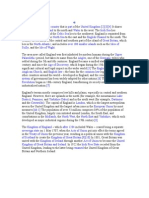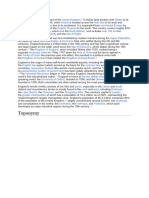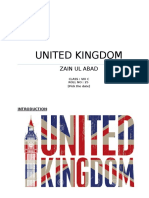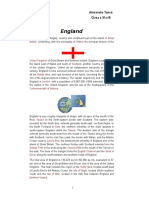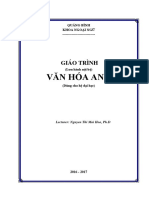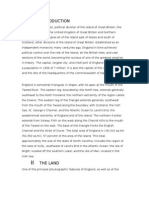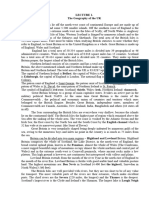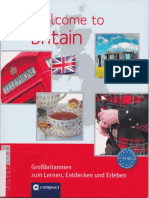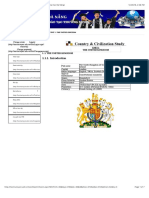England
England
Uploaded by
apoel97Copyright:
Available Formats
England
England
Uploaded by
apoel97Original Title
Copyright
Available Formats
Share this document
Did you find this document useful?
Is this content inappropriate?
Copyright:
Available Formats
England
England
Uploaded by
apoel97Copyright:
Available Formats
England i/lnd/ is a country that is part of the United Kingdom.
[6][7][8] It shares land borders with Scotland to the north and Wales to the west; the Irish Sea is to the north west, the Celtic Sea to the south west, with the North Sea to the east and the English Channel to the south separating it from continental Europe. Most of England comprises the central and southern part of the island of Great Britain in the North Atlantic. The country also includes over 100 smaller islands such as the Isles of Scilly and the Isle of Wight. The area now called England was first inhabited by modern humans during the Upper Palaeolithic period, but it takes its name from the Angles, one of the Germanic tribes who settled during the 5th and 6th centuries. England became a unified state in AD 927, and since the Age of Discovery, which began during the 15th century, has had a significant cultural and legal impact on the wider world.[9] The English language, the Anglican Church, and English lawthe basis for the common law legal systems of many other countries around the worlddeveloped in England, and the country's parliamentary system of government has been widely adopted by other nations.[10] The Industrial Revolution began in 18th-century England, transforming its society into the world's first industrialised nation.[11] England's Royal Society laid the foundations of modern experimental science.[12] England's terrain mostly comprises low hills and plains, especially in central and southern England. However, there are uplands in the north (for example, the mountainous Lake District, Pennines, and Yorkshire Dales) and in the south west (for example, Dartmoor and the Cotswolds). London, England's capital, is the largest metropolitan area in the United Kingdom and the largest urban zone in the European Union by most measures.[note 3] England's population is about 51 million, around 84% of the population of the United Kingdom, and is largely concentrated in London, the South East and conurbations in the Midlands, the North West, the North East and Yorkshire, which each developed as major industrial regions during the 19th century. Meadowlands and pastures are found beyond the major cities. The Kingdom of Englandwhich after 1284 included Waleswas a sovereign state until 1 May 1707, when the Acts of Union put into effect the terms agreed in the Treaty of Union the previous year, resulting in a political union with the Kingdom of Scotland to create the new Kingdom of Great Britain.[13][14] In 1801, Great Britain was united with the Kingdom of Ireland through another Act of Union to become the United Kingdom of Great Britain and Ireland. In 1922, the Irish Free State was established as a separate dominion, but the Royal and Parliamentary Titles Act 1927 reincorporated into the kingdom six Irish counties to officially create the current United Kingdom of Great Britain and Northern Ireland.
You might also like
- Final Exam Eduardo Ballesteros 1103 Nivel 3Document6 pagesFinal Exam Eduardo Ballesteros 1103 Nivel 3Eduardo Antonio Ballesteros Meza100% (1)
- Weekly Lesson Plan: Pry 5 (10years) Third Term Week 1Document12 pagesWeekly Lesson Plan: Pry 5 (10years) Third Term Week 1Kunbi Santos-ArinzeNo ratings yet
- Lecture 1 Great Britain and The UKDocument143 pagesLecture 1 Great Britain and The UKქეთი ნოზაძეNo ratings yet
- Cultura Si Civilizatie Lectia 1Document4 pagesCultura Si Civilizatie Lectia 1chalonniaaNo ratings yet
- 42 The Norman Conquest. The Influence of French Upon The English Language. Borrowings and CalcsDocument21 pages42 The Norman Conquest. The Influence of French Upon The English Language. Borrowings and CalcsIvania Serrano100% (2)
- English For Academic and Professional Purposes EAPP 111Document214 pagesEnglish For Academic and Professional Purposes EAPP 111Yoshio Matsuo67% (12)
- England 1Document1 pageEngland 1ZamaniNo ratings yet
- ENGLANDDocument1 pageENGLANDsajmirNo ratings yet
- England Is ADocument2 pagesEngland Is AȘova AngelicaNo ratings yet
- EnglandDocument1 pageEnglandSophiaNo ratings yet
- EnglandDocument1 pageEnglandStephy DanielsNo ratings yet
- NglandDocument1 pageNglandsomebody idkNo ratings yet
- ENGLANDDocument1 pageENGLANDcojocaru.marioflorinNo ratings yet
- Document 11Document1 pageDocument 11somebody idkNo ratings yet
- Europe TourDocument3 pagesEurope TourSania NaruNo ratings yet
- Britain The Four LandsDocument21 pagesBritain The Four LandsEduard PustianuNo ratings yet
- How The Uk Was MadeDocument3 pagesHow The Uk Was MadeLaura CervantesNo ratings yet
- United Kingdom: Dobre Silviu Clasa A VIII-a BDocument7 pagesUnited Kingdom: Dobre Silviu Clasa A VIII-a BVlad17No ratings yet
- MAKALAH Negara InggrisDocument15 pagesMAKALAH Negara InggrissandrakimNo ratings yet
- EnglandDocument1 pageEnglandGufron RosidiNo ratings yet
- UKDocument1 pageUKplayingpiano2100No ratings yet
- Lectures 1 15 Students Fundation of British Studies M. Rusieshvili Adn T.cartledge 1Document156 pagesLectures 1 15 Students Fundation of British Studies M. Rusieshvili Adn T.cartledge 1Fidan GajievaNo ratings yet
- United Kingdom: Zain Ul AbadDocument7 pagesUnited Kingdom: Zain Ul Abadadeeba hassanNo ratings yet
- Why Is England or The UK Sometimes Called 1Document27 pagesWhy Is England or The UK Sometimes Called 1Rias Wita SuryaniNo ratings yet
- Lecture 1 Great Britain and The UKDocument154 pagesLecture 1 Great Britain and The UKAnida MuradyanNo ratings yet
- Inglaterra: Anthem: VariousDocument4 pagesInglaterra: Anthem: VariousjhoelNo ratings yet
- AnliaDocument2 pagesAnliakostianoajazi85No ratings yet
- United KingdomDocument9 pagesUnited KingdomAsun LeónNo ratings yet
- Engle ZaDocument1 pageEngle ZaVladNo ratings yet
- The British IslesDocument3 pagesThe British IslesLeraNo ratings yet
- EnglandDocument8 pagesEnglandChryss26No ratings yet
- CursThe United KingdomDocument4 pagesCursThe United KingdomAndrew Si WallyNo ratings yet
- United Kingdom History, Population, Map, Flag, Capital, & Facts BritannicaDocument1 pageUnited Kingdom History, Population, Map, Flag, Capital, & Facts BritannicababiruwahabuNo ratings yet
- Chiță Ștefan Clasa A IX A Seral: Great Britain RegionsDocument4 pagesChiță Ștefan Clasa A IX A Seral: Great Britain Regionsramona ionescuNo ratings yet
- United KingdomDocument10 pagesUnited KingdomjackNo ratings yet
- EnglandDocument25 pagesEnglandIrvan KhoNo ratings yet
- англDocument12 pagesанглLenaNo ratings yet
- British CultureDocument9 pagesBritish CultureAlexandruAlexNo ratings yet
- All About U.K.: Find Out More About The UK PopulationDocument14 pagesAll About U.K.: Find Out More About The UK Populationhenin1990No ratings yet
- The UK: There Is An Important Difference Between The Terms Great Britain and United KingdomDocument2 pagesThe UK: There Is An Important Difference Between The Terms Great Britain and United KingdomPD PD (Veliký hrāč)No ratings yet
- JCXDCDocument3 pagesJCXDCNhân Trí NguễnNo ratings yet
- 2 - Document 2ndDocument2 pages2 - Document 2ndvivekNo ratings yet
- Geography - of - Great - Britain (Theory)Document6 pagesGeography - of - Great - Britain (Theory)Polina BelousNo ratings yet
- 5Document2 pages5lemoda8171No ratings yet
- Brexit Project ReportDocument60 pagesBrexit Project ReportRonak ji100% (1)
- Chapter 1. The United KingdomDocument31 pagesChapter 1. The United KingdomKhanh HoaNo ratings yet
- Great Britain 1Document4 pagesGreat Britain 1calinaNo ratings yet
- EnglandDocument3 pagesEnglandTeodor RaresNo ratings yet
- Great Britain-The Four LandsDocument15 pagesGreat Britain-The Four LandsMarian Chermaci100% (1)
- Uk AssignmentDocument2 pagesUk Assignmentsuman parajuliNo ratings yet
- CULTURADocument8 pagesCULTURAIoana IonitaNo ratings yet
- Presentation: United Kingdon: Executed:Soroca GheorgheDocument7 pagesPresentation: United Kingdon: Executed:Soroca GheorgheGicu SorocaNo ratings yet
- United Kingdom Dossier Nuevo 2021 para Lengua Inglesa 1Document17 pagesUnited Kingdom Dossier Nuevo 2021 para Lengua Inglesa 1Alejandro CórdobaNo ratings yet
- Group 1 - Introduction To The United KingdomDocument49 pagesGroup 1 - Introduction To The United Kingdomhueman126No ratings yet
- United Kingdom: United Kingdom of Great Britain and Northern IrelandDocument13 pagesUnited Kingdom: United Kingdom of Great Britain and Northern IrelandAkhil V SukumarNo ratings yet
- Adss U.kfactsandfiguresDocument11 pagesAdss U.kfactsandfigurest2bnv5k67rNo ratings yet
- Tasks The UKDocument59 pagesTasks The UKnovaklara64No ratings yet
- Giao Trinh Van Hoa Anh Dung Cho He Dai HocDocument51 pagesGiao Trinh Van Hoa Anh Dung Cho He Dai HocÝ Nguyễn Như100% (1)
- 1 Lingvostranovedcheskiy Zhurnal 1 VelikobritaniDocument18 pages1 Lingvostranovedcheskiy Zhurnal 1 VelikobritaniAndre koulasovNo ratings yet
- England (Latin Anglia), Political Division of The Island of Great Britain, TheDocument31 pagesEngland (Latin Anglia), Political Division of The Island of Great Britain, Theeu_giugiuxNo ratings yet
- Presentation On United Kingdom: Flag Royal Coat of ArmsDocument16 pagesPresentation On United Kingdom: Flag Royal Coat of ArmsMd.Saquib KhanNo ratings yet
- Cursuri 1-6 PDFDocument37 pagesCursuri 1-6 PDFfrozenglxNo ratings yet
- PDF‑документDocument17 pagesPDF‑документСаяна ДжумагалиеваNo ratings yet
- Anglo SaxonsDocument3 pagesAnglo SaxonsJoana BenevaNo ratings yet
- Eng Literature - Secular ProseDocument2 pagesEng Literature - Secular ProseIrma IvankovićNo ratings yet
- Customs and Traditions in England - 20231203 - 233801 - 0000Document18 pagesCustoms and Traditions in England - 20231203 - 233801 - 0000muqimovamuxlisaNo ratings yet
- Britain: Welcome ToDocument89 pagesBritain: Welcome ToasusgusNo ratings yet
- Heptarchy: Prepared by Lyudmyla Pasieka and Natalia Honchar Group 3FBDocument15 pagesHeptarchy: Prepared by Lyudmyla Pasieka and Natalia Honchar Group 3FBNatasha Honchar100% (1)
- Ugradcourses PDFDocument21 pagesUgradcourses PDFA. A. SuleimanNo ratings yet
- Time Pieces - Watches Silver 1770 - 1784Document333 pagesTime Pieces - Watches Silver 1770 - 1784The 18th Century Material Culture Resource Center100% (3)
- 9708 Economics: MARK SCHEME For The May/June 2008 Question PaperDocument2 pages9708 Economics: MARK SCHEME For The May/June 2008 Question PaperPhaltu GraphyNo ratings yet
- The British Isles. Histories, Cultures and Identities. Lecture Notes. Ioana MohorDocument87 pagesThe British Isles. Histories, Cultures and Identities. Lecture Notes. Ioana MohorAlexandra GrigoreNo ratings yet
- Review of Garden History: Lesson AimDocument12 pagesReview of Garden History: Lesson AimEmmanuel MonzeNo ratings yet
- Butler Music at The Court of Elizabeth I PDFDocument346 pagesButler Music at The Court of Elizabeth I PDFAndre Nieuwlaat100% (1)
- PROJECT ENGLISHT ... Destinations in The WorldDocument7 pagesPROJECT ENGLISHT ... Destinations in The WorldAurela Elezaj100% (2)
- 5090 BIOLOGY: MARK SCHEME For The May/June 2007 Question PaperDocument2 pages5090 BIOLOGY: MARK SCHEME For The May/June 2007 Question PaperMasimba MunanguNo ratings yet
- The Golden Age of Late Medieval CitiesDocument6 pagesThe Golden Age of Late Medieval CitiesThomasHubertNo ratings yet
- Novia Anggi Lestari (2310732031) - Midterm Exam Helit CDocument6 pagesNovia Anggi Lestari (2310732031) - Midterm Exam Helit CNovia Anggi LestariNo ratings yet
- Interesting Facts About Cricket and Its HistoryDocument1 pageInteresting Facts About Cricket and Its HistoryErnesto SernaNo ratings yet
- The History of Tourism and HospitalityDocument6 pagesThe History of Tourism and HospitalityKarima HijaraNo ratings yet
- Bài giảng văn hoá AnhDocument7 pagesBài giảng văn hoá Anhnewlife4390% (1)
- Bingo Project Report FinalDocument80 pagesBingo Project Report FinalMab ShiNo ratings yet
- Women in English LifeDocument384 pagesWomen in English LifecemopsNo ratings yet
- Avoiding Stairs Tube GuideDocument16 pagesAvoiding Stairs Tube GuideWNo ratings yet
- Merchants and JewsDocument272 pagesMerchants and JewsandrewNo ratings yet
- Get Victorian Christianity and Emigrant Voyages To British Colonies C 1840 C 1914 1st Edition Strong Free All ChaptersDocument84 pagesGet Victorian Christianity and Emigrant Voyages To British Colonies C 1840 C 1914 1st Edition Strong Free All Chaptersdobiyameschi100% (11)
- Armyvisits - 3 HTTP://WWW - Seanmcgrath.co - UkDocument385 pagesArmyvisits - 3 HTTP://WWW - Seanmcgrath.co - UkSeanyP321No ratings yet
- Cross Cultural Understanding Name's of Group: 1. Eltami Lenia Sari (17050005) 2. Eka Aprilia S (17050033) 3. Merlin Ambarwati (17050046)Document4 pagesCross Cultural Understanding Name's of Group: 1. Eltami Lenia Sari (17050005) 2. Eka Aprilia S (17050033) 3. Merlin Ambarwati (17050046)Dela eka fitraNo ratings yet
- Victorian PeriodDocument12 pagesVictorian PeriodTaibur Rahaman100% (1)



